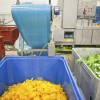Abstract
A clean break is needed between groups of products for food protection regulators to consider produce as separate from other produce packed off the same line. Determining a clean break is important to limit the scope of a recall. Packers can determine lot size based on what is practical and the amount of risk that their business is comfortable with. Food protection regulators define lot size as when a clean break occurs before and after a group of products. For instance, if a packer chooses to have a daily documented and verified clean break, the packer would establish one lot per day, as defined by food protection regulators. In other situations, a packer may choose to have a clean break conducted weekly, meaning that a food safety incident could result in a week’s worth of production being recalled. This 2-page fact sheet was written by B. Chapman and M.D. Danyluk and published by the UF Department of Food Science and Human Nutrition, August 2013.
References
“Current Good Manufacturing Practice and Hazard Analysis and Risk-Based Preventive Controls for Human Food.” 78 Federal Register 11 (16 January 2013). http://www.gpo.gov/fdsys/pkg/FR-2013-01-16/html/2013-00125.htm.
Unless otherwise specified, articles published in the EDIS journal after January 1, 2024 are licensed under a Creative Commons Attribution-NonCommercial-NoDerivs 4.0 International (CC BY-NC-ND 4.0) license.

